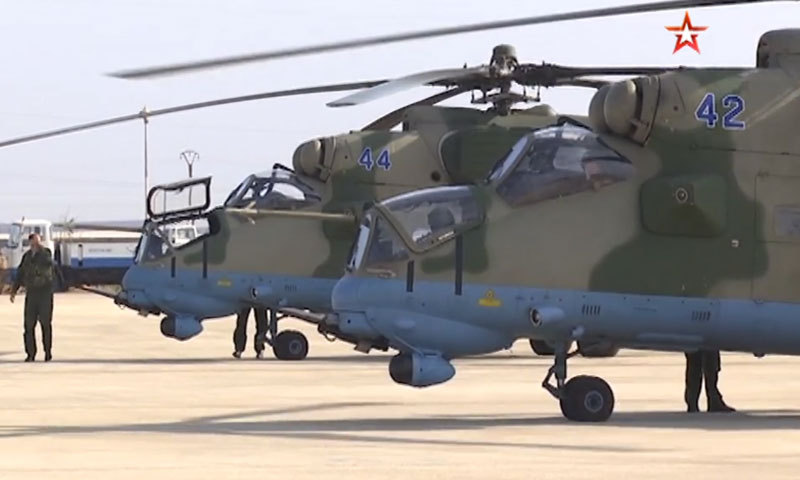Enab Baladi – Taim al-Haj
The city of Qamishli and its airport, have witnessed a remarkable development due to Russia’s deployment of an air defense system at the airport. By so doing, Moscow has raised the profile of Qamishli, which has witnessed, since the cessation of the Turkish military operation in the eastern Euphrates region on 22 October, a deployment of Russian and US military patrols, in addition to sharing control over the city between the Syrian regime’s forces and the Syrian Democratic Forces (SDF).
Russia relocated air defense systems and three helicopters, one Mil Mi-8 and two Mil Mi-35, from Hmeimim Air Base in Latakia to Qamishli Airport in Hasakah on 14 November, according Russian news agency tvzvezda, which described the event as “historic.”
The Head of the Aviation Commandant Office, Timur Khodzhaev, confirmed the relocation of a Panzer air defense system to Qamishli Airport, in order to protect the aircrafts from the ground, in addition to the presence of a control tower and medical examination places for pilots.
Although SDF controls most of the areas in Hasakah and Qamishli, the latter’s airport has remained under regime’s control for years.
Russia is trying to establish its own military base in the region, in a clear rivalry with Turkey, which had previously started establishing its own permanent military bases in northeastern Syria.
The Russian military moves in Qamishli come with the redeployment of US forces in Syria near the oil fields in the governorates of Hasakah and Deir ez-Zor, and their evacuation of several military bases in the countrysides of Hasakah and Aleppo. This has allowed Russia to fill the vacuum the US has left in those bases, as happened recently in the Sarrin military base in the countryside of Ayn al-Arab on the Turkish-Syrian borders.
Third base
Moscow’s move at Qamishli airport has prompted some Russian analysts to question whether the administration of Russian President Vladimir Putin is seeking to make Qamishli Airport a third Russian base in Syria, along with the Hmeimim and Tartous bases on the Syrian coast.
Dmitry Rodionov, a professor at the Higher School of Economics, wrote an article in the Russian newspaper Svobodnaya Pressa on 14 November entitled “Russia cuts off oxygen on Americans by establishing another base in Syria.”
Rodionov argued that the establishment of a third Russian military base in Syria is necessary if Moscow intends to seriously remain in the region for a long time, so as to ensure that its interests are taken into account in the event of reconstruction in Syria.
“The presence is not in the form of a military base (meaning Qamishli Airport), but in the form of a joint monitoring mission, which should ultimately lead to the organization of oil transportation from there, with the participation of both Turks and Americans,” added Rodionov.
He considered that everything that is being published about Russia’s possibility of establishing another military base in Qamishli is closer to “leaks” aimed at fueling tension between Russia and Turkey.
According to Asharq al-Awsat newspaper, Moscow has also deployed at the airport dozens of armored machineries and vehicles, which participate in joint patrols with Turkish forces in northern Syria.
The newspaper quoted “Russian sources” claiming that Moscow is working to strengthen the arming and securing of Qamishli Airport, through the deployment of multi-range missile systems, allowing it to monitor the movements of US aircrafts in large areas covering the Iraqi and Turkish territories.
The newspaper added that Moscow is holding discussions with the Syrian regime to sign an agreement ensuring Russia’s permanent presence at the airport, similar to the two agreements that regulate the Russian presence at the Hmeimim Air Base and Tartous Naval Facility, which Moscow is currently developing and expanding to turn it into a naval base well-equipped to receive huge ships.
Russian news agency, RIA Novosti, said that Russian helicopters, which are stationed at Qamishli Airport, will gradually expand the field of surveillance, noting that the current surveillance area includes Hasakah Governorate on the borders with Turkey and Iraq.
It seems that Russia’s moves in Qamishli Airport are aimed at securing the activity of the Russian military police and organizing the work of air patrols in which helicopters participate. As a matter of fact, after arriving in Qamishli, these helicopters conducted joint patrols with Turkey along the Syrian-Turkish borders, in implementation of the Sochi Agreement between the Turkish president Recep Tayyip Erdoğan and his Russian counterpart Vladimir Putin.
The two presidents agreed, on 22 October, to completely eliminate all Kurdish forces from the Syrian borderlines, to a depth of 30-km, within 150 hours, in addition to removing these forces’ weapons from Manbij and Tal Rifat.
The agreement also provided for the management of joint patrols at a depth of 10-km along the borders, with the exception of Qamishli, while maintaining the Turkish presence between the cities of Tell Abyad and Ras al-Ayn.
The Russian military police has afterwards started conducting its patrols on the borders in implementation of the agreement and sent military equipment and hundreds of army officers to the region.











